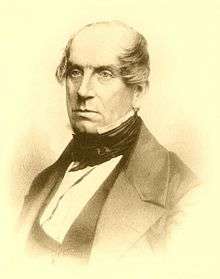Ogden Hoffman
| Ogden Hoffman | |
|---|---|
 | |
| Member of the U.S. House of Representatives from New York's 3rd district | |
|
In office 1837 – 1841 with Churchill C. Cambreleng 1837–39, Ely Moore 1837–39, Edward Curtis 1837–41, James Monroe 1839–41 and Moses H. Grinnell 1839–41 | |
| Preceded by | Churchill C. Cambreleng, Gideon Lee, Ely Moore, John McKeon |
| Succeeded by | Charles G. Ferris, Fernando Wood, James I. Roosevelt, John McKeon |
| Personal details | |
| Born |
October 13, 1794 Manhattan, New York |
| Died |
November 24, 1877 (aged 74) New York City |
| Political party |
Democratic Party Whig |
| Spouse(s) |
Emily Burrall Virginia Southard |
| Children | 5 |
| Parents |
Josiah Ogden Hoffman Mary Colden |
Ogden Hoffman (October 13, 1794 – May 1, 1856) was an American lawyer and politician who served two terms in the United States House of Representatives.
Life
Ogden Hoffman was born on October 13, 1794, the son of New York Attorney General Josiah Ogden Hoffman (1766–1837) and Mary (Colden) Hoffman. He pursued classical studies and graduated from Columbia College in 1812.[1]
Career
He served for three years in the Navy and was warranted a midshipman in 1814. He took part in the War of 1812 and the Second Barbary War as a crew member on the USS President, and was taken prisoner when the President was captured in 1814.
After leaving the Navy he studied law under his father, was admitted to the bar in 1818, and commenced practice in Goshen, New York.
Political career
Hoffman was District Attorney of Orange County from May 1823 to January 1826, and a member of the New York State Assembly (Orange Co.) in 1826. He then returned to New York City and there practiced law in partnership with Hugh Maxwell, who was New York County District Attorney.
Hoffman was again a member of the New York State Assembly (New York Co.) in 1828; and was New York County District Attorney from 1829 to 1835.
He disagreed with the Jackson administration over the need for a federally chartered central bank, and abandoned Tammany Hall and the Democratic Party for the Whigs after Jackson's decision not to re-charter the Second Bank of the United States.
In 1836, Hoffman defended Richard P. Robinson at his trial for the murder of Helen Jewett, and got his client acquitted.
Hoffman was elected as a Whig to the 25th and 26th United States Congresses, holding office from March 4, 1837, to March 3, 1841. He was United States Attorney for the Southern District of New York from 1841 to 1845; and was New York Attorney General from 1854 to 1855, elected on the Whig ticket at the New York state election, 1853.
Personal life
On June 27, 1819, he married Emily Burrall, and they had two children:
- Ogden Hoffman, Jr. (1822–1891), who served as a federal judge in California for more than 40 years.
In November 1838, he married Virginia Southard (died 1886), and they had three children.
He died on May 1, 1856, at his home on Ninth Street in New York City, of "congestion of the lungs." He was buried at St. Mark's Church in-the-Bowery.[2]
References
- ↑ "HOFFMAN, Josiah Ogden - Biographical Information". bioguide.congress.gov. Biographical Directory of the United States Congress. Retrieved 15 September 2016.
- ↑ Ogden Hoffman at Find a Grave
Sources
- United States Congress. "Ogden Hoffman (id: H000687)". Biographical Directory of the United States Congress.
- The New-York Civil List compiled by Franklin Benjamin Hough (pages 35, 253, 257, 353 and 431; 1863)
- Death of the Hon. Ogden Hoffman in the New York Times on May 2, 1856
- Genealogy of the Hoffman Family by (Dodd, Mead & Co., NYC; pg. 279ff)
| Legal offices | ||
|---|---|---|
| Preceded by Hugh Maxwell |
New York County District Attorney 1829–1835 |
Succeeded by Thomas Phoenix |
| United States House of Representatives | ||
| Preceded by Churchill C. Cambreleng, Gideon Lee, Ely Moore, John McKeon |
Member of the U.S. House of Representatives from New York's 3rd congressional district 1837–1841 with Churchill C. Cambreleng 1837–39, Ely Moore 1837–39, Edward Curtis 1837–41, James Monroe 1839–41 and Moses H. Grinnell 1839–41 |
Succeeded by Charles G. Ferris, Fernando Wood, James I. Roosevelt, John McKeon |
| Legal offices | ||
| Preceded by Benjamin F. Butler |
U.S. Attorney for the Southern District of New York 1841–1845 |
Succeeded by Benjamin F. Butler |
| Preceded by Gardner Stow |
New York Attorney General 1854–1855 |
Succeeded by Stephen B. Cushing |